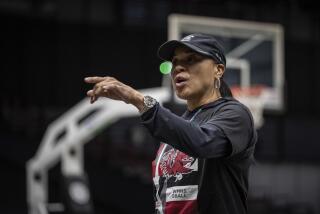College Gap Between Sexes Narrows, but Pay’s Uneven
- Share via
WASHINGTON — The college education gap between men and women is the narrowest in the generation since Americans started pouring into universities in huge numbers, but there is still a major income disparity between the sexes, the government reported Wednesday.
Despite the virtual parity in higher education, women continue to be concentrated in comparatively lesser-paid jobs and earn about 70 cents for every dollar earned by men, the Census Bureau said in its annual report on the status of women.
Overall, 27.8% of American men have completed a college education, compared with 23.6% of women, the report said. The figures are compiled from a survey sample of households and offer an early glimpse of the kind of detailed information expected to emerge from the decennial census, conducted in 2000.
“There has been an important growth in educational attainment for women,” said Renee E. Spraggins, the author of the Census Bureau report. In 1970, for example, just 8.2% of all women had received college degrees, compared with 14.1% of men.
With many female workers concentrated in comparatively lower-paid jobs, the pay gap remains significant.
Among all workers, women who worked full time in 1999 had median earnings of $26,300, equal to 72% of the median earnings of $36,500 for men. (Median is the midpoint; half earn more and half less.)
Women with a high school degree had a median income of $21,563, about 70% of men’s earnings of $30,868.
The overall educational gap for men and women in the nation’s labor force will disappear relatively soon, because women and men now graduate from high school in equal percentages, and women are slightly more likely to attend college.
Although having a higher education delivers more cash for both men and women, it does not offer a parity of earnings.
Women with college degrees make about 69 cents on the dollar compared with men with the same education. The median income was $34,408, compared with $49,982 for men.
“We’ve seen more and more women going to college, and I don’t think it’s any surprise that the education gap is closing,” said M. Cindy Hounsell, executive director of the Women’s Institute for a Secure Retirement, a research organization. “The problem is the pay gap--it is not closing. Even with a college degree, they make less than men.”
Women who left their careers temporarily to raise children are “penalized and never catch up” in terms of pay and benefits when they return to work, she said.
“When people have additional education, their wages go up, which is terrific, but women do not get the same bang for a buck as men” in getting the financial benefits from going to college, said Jocelyn Frye, director of legal and public policy at the National Partnership for Women and Families, a group that deals with policies on balancing work and family.
The gaps are unexplained, with theories pointing to several possible causes. “Our concern has always been, what part can be explained by differences of experience and what part is due to discrimination or other unexplained factors?” Frye asked.
The majority of women, about 58%, work in support and service professions, including clerical and sales jobs, many of which offer comparatively low pay. About 30% of men work in these fields.
“We see many more women in the labor force, and many more women earning college degrees,” said Spraggins of the Labor Department, pointing to the acceleration of two parallel long-term trends.
Women’s labor force participation has been rising steadily. About 74% of men and 61% of women were in the labor market last year, either working or actively seeking a job.
The trends show a dramatic rise in the number of women who are balancing the challenges of work and home. A record 59% of women with children under the age of 1 were working in 1998, compared with 31% back in 1976.
(BEGIN TEXT OF INFOBOX / INFOGRAPHIC)
Women and Men
The Census Bureau’s report, the March 2000 Current Population Survey, identifies gender differences in education and earnings:
*
Percent age 25 and older with a high school diploma
Women: 84%
Men: 84%
*
Percent age 25 and older with a bachelor’s degree or higher
Women: 24%
Men: 28%
*
Percent age 16 and older who are in the labor force
Women: 61%
Men: 74%
*
1999 median earnings (for those age 15 and older who worked full time year round
Women: $26,300
Men: $36,500
*
Percent in poverty in 1999
Women: 13.2%
Men: 10.3%
*
Source: Census Bureau’s March 2000 Current Population Survey
*
REBECCA PERRY / Los Angeles Times
More to Read
Sign up for Essential California
The most important California stories and recommendations in your inbox every morning.
You may occasionally receive promotional content from the Los Angeles Times.













